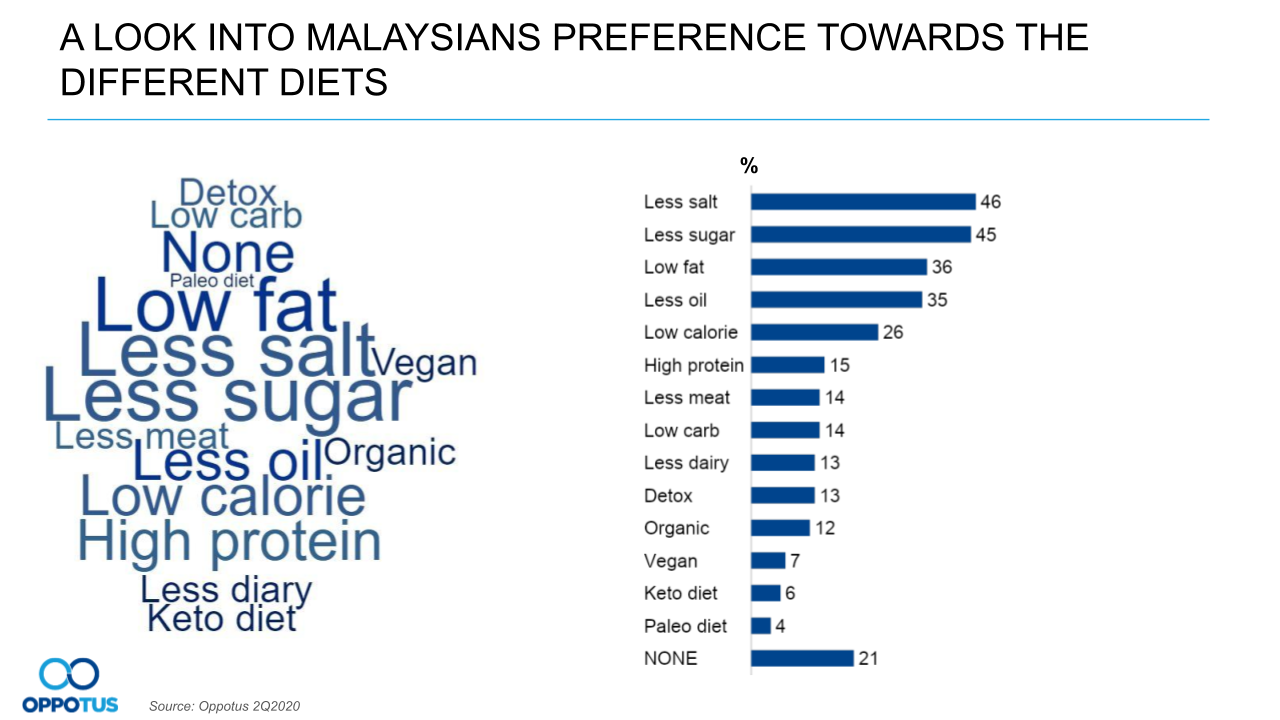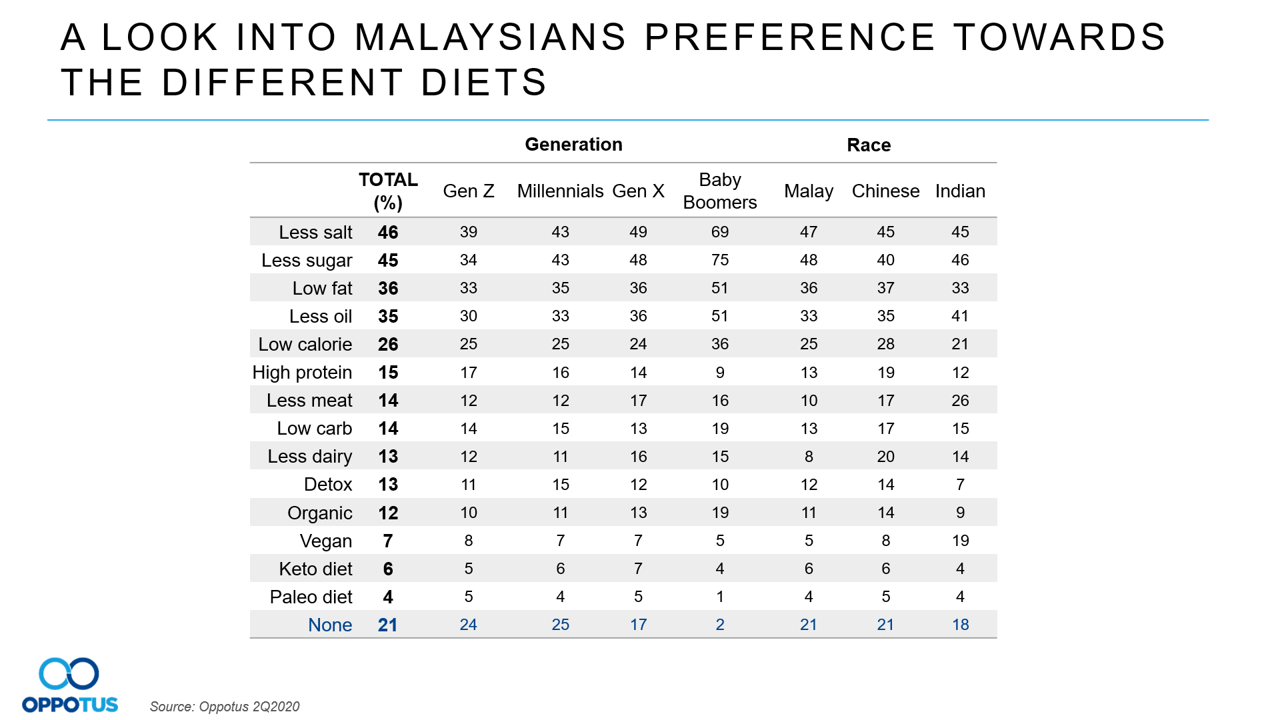Food trends in Malaysia: From the traditional nasi lemak, banana leaf rice, and char kuey teow to the more recent craze towards bubble tea, Malaysians unite on and love nothing more than to satisfy their taste-buds. Malaysians endearingly label themselves as ‘foodies’, always on the lookout for the best cuisines the world has to offer. But what exactly do they look for in food and what are their all time favourites?
Understanding consumer behaviour has never been more vital in the food and beverage industry due to high competition and consumer demand. With the country celebrating Hari Raya now, and the recent trend of food deliveries due to the Movement Control Order (MCO), eateries are dishing out their best promotions to attract these customers. Facing such intense competition, how can brands capture the market better than the other? So we spoke to over 1300 Malaysians and distilled some insights on Malaysian food trends, identifying the preferences of Malaysians towards food in terms of diets, flavours, cooking styles, and more.
What kinds of diets do Malaysians prefer?
A diet determines what a person habitually eats and we found some interesting food trends among the consumers in Malaysia. Most (80%) Malaysians have some form preference when it comes to the food they eat. Healthy living and eating is definitely an interest for them. Diets such as less salt (46%), less sugar (45%), low oil (35%) and low fat (36%) are among the most common preferences exercised by the Malaysian consumer, with baby boomers (those aged 57 and above) showing the highest tendencies towards these diet/ lifestyles. This indicates that they place more importance on their health which may be attributed to their age.

Another noteworthy point is the higher tendency for Indians to eat less meat (26%) and vegan (19%) diets compared to the other races. Though religion plays a role it is also a known fact that vegan diets are healthy in addition to other environmental and ethical benefits. Besides that, Chinese consumers surprisingly prefer a less dairy (20%) intake approach.
Despite the growing hype for diet plans thanks to their dissemination through social media, 21% of consumers do not pertain to any specific diet, which tends to be the Gen Z and Millennials.
How often do Malaysians eat out?

On average, most consumers eat out 15-16 times a month, with Millennials showing the highest frequency of the different segments. Baby Boomers (57-65 year olds) however are less inclined to do so, almost half (46%) of them eat out once a week or less.

In terms of location, more people in Klang Valley eat out everyday the most compared to other states. Klang Valley lies in a strategic location at the centre of Selangor, and as a developed metropolitan area it holds a large population of working adults who find eating out convenient in their busy work lives.
In contrast, those who reside in Kuantan rarely eat out on a daily basis, with only 1% of residents reporting that they eat out every day. Kuantan is an area known for its amazing sights and slow paced lifestyle compared to the large cities of Malaysia, thus, residents may not see much appeal in eating out often, nor do they need the speed and convenience that it brings.
Based on the graph below, Baby Boomers rarely eat out more than once a week, but when they do so it is mostly on the weekends making it 80% of people in that category in contrast to the mere 54% for weekdays. In general there isn’t much distinction between eating out during the weekday or weekends among consumers. However, our survey found that Penang has a unique trend of eating out more often on weekdays than on weekends. Considering the large population of Chinese in Penang, the trend coincides with how Chinese consumers tend to eat out during the weekday more often than other races as well.

What do Malaysians prefer when eating out?
Malaysia offers a variety of dishes thanks to our multicultural background. Each cultural group has its own unique flavours and different cooking styles. Most people assume that ethnic groups would naturally prefer food from their own cultures but that may not hold true in this age of food trends where fusion food has become more common. A colourful array of delicacies has been introduced to the market over the years as more vendors from around the world enter the F&B market, bringing their own local dishes to Malaysia. And also, did we mention Malaysians love all types of food?
According to our survey, Malay food tops the chart as the number one favourite go-to cuisine which comes as no surprise. As our native cuisine it’s a taste everyone is familiar with and continues to love from their childhood to their adulthood (think nasi lemak). Additionally it is always a good option for breakfast, lunch, or dinner.
Coming in second and third place are Mamak and Thai respectively. Malaysians are known for their Mamak culture and it is especially popular among young adults. Mamaks offer speedy services at decent prices in addition to providing an atmosphere perfect for gatherings so it’s no wonder that they are hotspots for people from all walks of life.
Meanwhile Chinese and American cuisine fall a little behind at 45% and 40% respectively. Though it is not a local cuisine, Thai food may hold a higher placement in this ranking due to its very spicy and fragrant flavours which make it more preferable to the tastes of the average Malaysian compared to Chinese and American cuisine. Vegetarian dishes have also managed to squeeze its way into the top 10 which shows their potential and reflect the changing consumer behaviour towards food trends, healthier diets and lifestyles.

The graphs below summarises the top 10 flavours and cooking styles of consumer preferences when eating out. Holding true to its title, chili is the spice of life which is an ingredient commonly used in curry, spicy, tomyam, and rendang dishes is most favoured by the palate of the average Malaysian consumer.

In terms of meat (or type of protein), chicken is by far the top choice, being consumed by 94% of Malaysians, followed by seafood (75%) and beef (64%). As for cooking styles, consumers reportedly like deep fried and grilled in general.
The main four flavours that Malaysians go for when it comes to Malay cuisine; curry, spicy, tomyam, and rendang hold strong to their positions. As does deep fry and grilled for cooking styles.
The diners for Mamak food lean slightly more on the male (54%) than female (46%) side. Furthermore, curry makes a notable 80% of consumer preference when it comes to flavours.

Naturally for Thai food, tomyum (84%) is the number one choice of flavours, with seafood showing higher levels of usage as part of the cuisine so far.

Consumer profile of Chinese cuisine is largely skewed to Chinese, who account for 73% of the occasions. Even though Chinese food also includes additional options for meat/protein such as pork and duck, chicken is still the most consumed. Furthermore, diners notably prefer mushroom (66%) and kam heong (64%) in addition to the usual curry, spicy and tomyam flavours when it comes to Chinese food.
Malays enjoy American cuisines, especially those centered in Klang Valley and Johor Bahru. The statistics also show that there are more female diners than male. For this category, cheese (71%) makes its way into the top 5 most preferred flavours, and grilled food takes top place as opposed to “fried”.
Overall, Malaysian food trends indicate that we prefer healthy diets but also enjoy an assortment of deep fried and grilled food. This may seem contradictory and a struggle to balance, but different cooking methods which replace ingredients such as vegetable oil with more healthy alternatives such as coconut oil do exist. These alternatives may provide equal health benefits without compromising the taste. At the same time, incorporating these substitutes would give the establishments a differentiation that is attractive to their customers.
If you would like to dig deeper into the data and get additional insights into the topic of food trends, feel free to contact us at: theteam@oppotus.com







